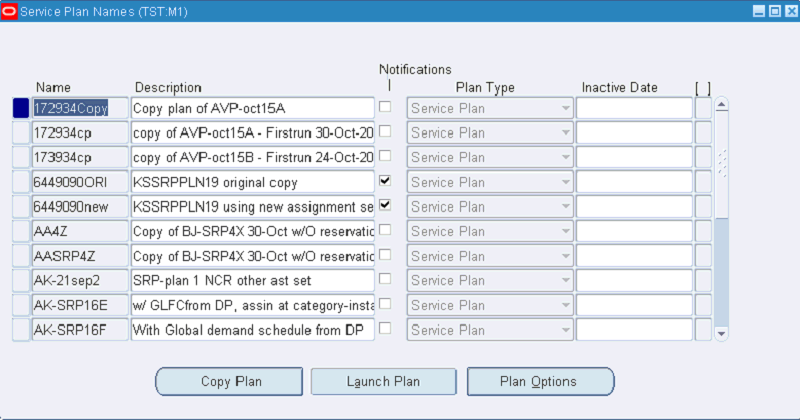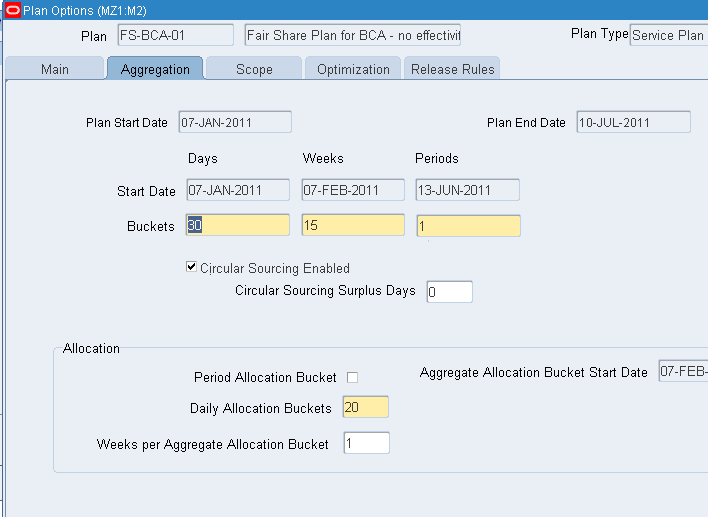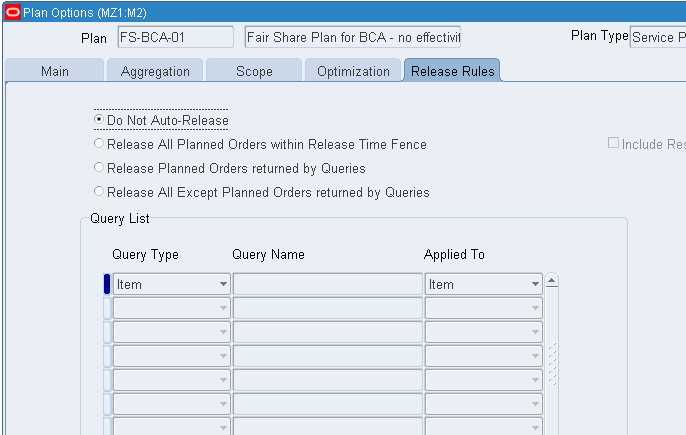Defining Service Plans
This chapter covers the following topics:
- Service Supply Chain Plan Name
- Service Supply Chain Plan Options
- Item Simulation Set (Mass Maintenance)
- Creating Item Simulation Sets
- Reverting to Original Values
- Item Simulation Set Example
- Updateable Attributes List
- Criticality Matrix
- Setting the MSC:Criticality Category Set Profile Option
- Criticality Rules
- Creating and Executing a Criticality Query
Service Supply Chain Plan Name
You use the Service Plan Names form for defining multiple plans, and storing them against plan names. You can access the Service Plan Names form from the Service Supply Chain Planner responsibility Navigator.
Service Parts Planning > Names
The design and uses of this form are similar to those of the DRP Plan Name form, except that the Plan Type value is Service Plan. You cannot update the Plan Type field. The Plan Type Service Plan is not visible to Distribution Requirements Planning (DRP). Similarly DRP plans are not visible to SPP. Inventory Optimization users can see and use DRP and SPP plan types, but cannot generate plans based on a mix of definitions from both plan types.
Service Supply Chain Plan Options
You specify plan options to define the scope of the named plan, and control many aspects of the plan generation.
You can access Plan Options in one of the following ways:
-
From Service Plan Names, select a plan, and then click Plan Options
-
From the Service Supply Chain Planner (responsibility) Navigator, select Service Parts Planning > Options
For more information about Plan Options, see Setting Distribution Plan Options, in the Defining Distribution Plans Chapter of the Oracle Advanced Supply Chain Planning Implementation and User Guide.
When you navigate to Plan Options from the navigator, a Find window opens for you to specify the Plan name for which you want to see the plan options.
Main Tab
On the Main tab you specify assignment set, item simulation set, demand priority rule, whether to overwrite supplies and manual forecasts, which type of date to schedule by, whether to enforce constraints and time fences, and so on.
See
Aggregation Tab
On the Aggregation tab, you specify the planning period and how it is divided into time buckets. You also specify whether circular sourcing is enabled.
| Field | Validation | Description | Default |
|---|---|---|---|
| Plan Start Date | Date | Start date for the plan. If you have never run the plan, this field displays today's date. If you have run the plan, this field displays the planning horizon start date of the last run. | sysdate |
| Plan End Date | Date | End date of the plan horizon. Calculated planning horizon end date based on your entries in Buckets and the owning organization calendar. | |
| Start Date | Calculated start date for each bucket based on your entries in buckets and the owning organization calendar. The value for the Days column is the plan start date. | ||
| Time Buckets Days, Weeks, Periods |
Integer | Telescopic planning horizon capability – Number of daily, weekly, and monthly time buckets within the planning horizon. Weekly buckets can start only on the week beginning day from the manufacturing calendar. If the daily horizon does not end on the day before a week beginning day, the planning engine extends it to the next day before a week beginning day. It plans the extended days in daily buckets, never minute or hourly buckets, regardless of any other settings. | |
| Circular Sourcing Enabled | Yes/No check box | Determines whether planning recommends transfer of supplies from existing inventory at other organizations | No |
| Circular Sourcing Surplus Days | Integer | Transfers are not recommended unless surplus exists for this quantity of days |
Daily Allocation Buckets
Daily allocation buckets are the number of buckets during which the allocation bucket size is one day. Null or zero value means that no daily allocation buckets are available. You must specify that the number of daily allocation buckets is less than or equal to the number of daily planning buckets.
Weeks per aggregate allocation bucket is the number of weeks contained in each aggregate allocation bucket. It can be an integer only. If the weeks per aggregate allocation bucket is two or more, then the last allocation bucket cannot contain that number of weeks (depending on how many weeks are left before the plan horizon end date). For example, if weeks per allocation bucket is two, but the plan horizon only allows one week in the last allocation bucket, only one week is used.
The plan horizon is not extended because of the allocation buckets. If daily allocation buckets exist, the aggregate buckets start on the next week start date and additional daily allocation buckets can be used. For example, if the daily allocation buckets end on a Thursday and the week start date is Monday, one additional daily allocation bucket is used (assuming that Saturday and Sunday are nonworking days).
Supply allocation proceeds bucket by bucket. Demands in the first bucket (daily, weekly or period) are sorted by priority and firm demands are given the highest priority. Within the bucket, for each demand priority, demands are allocated supplies on or before the demand date. If supplies are not available by the demand date, then they are allocated by the bucket end date. If a shortage occurs for a demand priority within an allocation bucket, the supplies are fair shared based on the supply allocation rules and plan options. Unsatisfied demands are carried forward to the next allocation bucket.
Inventory Rebalancing - Circular Sourcing
Scope Tab
The organizations and items included in the supply chain define the scope of the service plan.
Organizations Sub Tab
| Field Group | Validation | Description |
|---|---|---|
| Global Demand Schedules | The global demand schedules appear in the LOV. | Select the names of Oracle Demantra Demand Management scenarios that drive this plan. You can select scenarios that do not reference an organization (organization dimension set to All Organization). |
| Global Returns Forecasts | The global returns forecasts appear in the LOV. | Indicates the scenario for returns forecast. This is similar to global demand forecast, but to indicate returns, planning marks the scenario as returns. |
| Organizations | Field organizations are not part of the LOV. | |
| Demand Schedules | The local demand schedules and forecasts appear in the LOV. | Select the names of demand schedules, forecasts, and plans that drive this plan. |
| Supply Schedules | LOV includes forecast scenarios for return forecast as supply schedule | Select the name of supply schedules that participate in this plan. Note that this production schedule should be referencing this plan within its schedule options. That is, the schedule name that is entered should reference the plan on the Schedule Options page, Scope tab. |
| Return Forecasts (Demantra) | LOV includes Org Level forecasts as a schedule of defectives. | When a returns forecast is included in the context of an organization, SPP interprets that as a projected stream of defective supply coming into that organization. It then applies the sourcing rules assigned in the plan to handle the defectives coming in.
Note: Since all Demantra forecasts are available under the Returns Forecast LOV, it is possible to include the same Demantra forecast as both a Demand Schedule and a Returns schedule. Functionally this would mean that returns equal spares. |
Items Sub Tab
The Plan Options form Items sub tab provides attributes for specifying whether planning includes all items, all items from all categories within a specified category set, or items from listed categories within a specified category set.
First, you either select the Include All Items radio button, or the Include Items from the Following Category Set radio button. Choosing to include all items disables entry for category set and category.
Selecting the Include Items from the Following Category Set radio button enables the Include All Categories check box. Selecting this check box requires a choice from the LOV to specify a category set. These settings cause all items in all categories of the specified category set to be included in the plan.
When the Include Items from the following Category Set radio button is selected, and the Include All Categories check box is not selected, then you can choose from the Categories LOV to specify categories within the category set. These settings cause all items in listed categories of the specified category set to be included in the plan.
You cannot select multiple category sets. Once a category set is changed from the current category set, all categories are deleted from the lower part of the form. Subsequent attempts to change the category set of a saved plan encounter a warning.
Planning verifies and includes all related items in the plan, such as:
-
All items in the supersession chain for the selected item, regardless of the category of these items.
-
In case of a Depot Repair work order for the selected item, all dependent demand component items.
-
All the supplies generated by the plan.

| Field | Validation | Description | Default |
|---|---|---|---|
| Include All items | Yes/No radio button. | Indicates whether the plan should include all items. | Yes |
| Include Items from the following Category Set | If include all items = No LOV includes all categories. | Select the category set that contains the items you want to plan. | No |
| Include All Categories | Yes/No check box. | Include all items in all categories in the specified category set. | No |
| Category | LOV of categories within the specified category set. | Include all items in listed categories in the specified category set. | Null |
| Description | Displays the description of the selected category. | Null |
Optimization Tab
Select the Optimize check box to enable the Optimization tab, and then specify relative weights for the objectives. Valid objective weights range from zero to one.
For example, the following settings would favor plans that achieve high customer service (on-time delivery) at the cost of increased investment in inventory (low inventory turnover ratio):
-
Maximize inventory turns = 0.2
-
Maximize plan profit = 0.4
-
Maximize on-time delivery = 0.9
Note: The weights do not necessarily sum to 1.0. Also note that the relative weights indicate your preferences among these competing objectives. Thus, setting all these weights to 1.0 produces the same result as setting them all to zero.
You can also define Plan Level Penalty Factors, in percent, for exceeding material capacity, exceeding transportation capacity, and demand lateness. This action causes the planning engine to search for alternatives that minimize the total of these penalties.
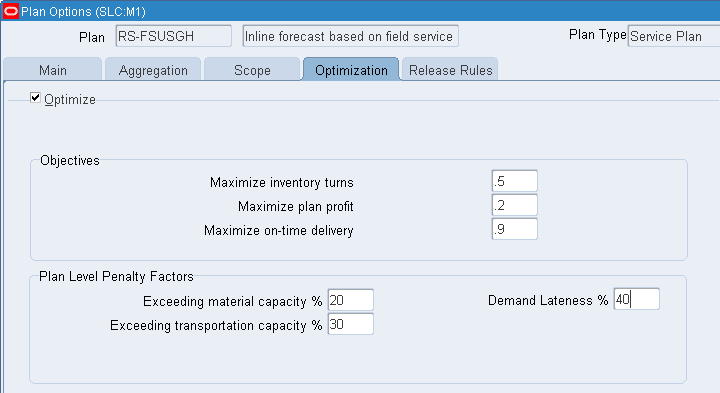
| Field | Validation | Description | Default |
| Maximize inventory turns | Number >= 0, <= 1 | Specify a weighting factor from 0 to 1. | 0 |
| Maximize plan profit | Number >= 0, <= 1 | Specify a weighting factor from 0 to 1. | 0 |
| Maximize on-time delivery | Number >= 0, <= 1 | Specify a weighting factor from 0 to 1. | 0 |
| Exceeding material capacity % | Positive Number | Enter a numerical value to quantify the impact of exceeding material capacity. For example, if you enter 20, the penalty factor is 20%. | 0 |
| Exceeding transportation capacity % | Positive Number | Enter a numerical value to quantify the impact of exceeding transportation capacity. For example, if you enter 30, the penalty factor is 30%. | 0 |
| Positive Number | Enter a numerical value to quantify the impact of late demand. For example, if you enter 40, the penalty factor is 40%. | 0 |
Release Rules Tab
The plan setup provides the following options for releasing orders:
-
The default selection is Do not Auto-Release orders in the plan. In this case, planners manually release planned orders.
-
Automatically Release All Planned Orders in the plan that lie within their associated release time fence. No rules are evaluated prior to release.
-
Release Planned Orders returned by Query - This option causes the plan to automatically release orders returned by the queries identified in the list below.
-
Release All EXCEPT Planned Orders returned by Query - This option causes the plan to automatically release all orders except those returned by the queries identified in the list below
Query List
For each auto-release query to be associated with the plan, fill in the appropriate information for each row.
Select the type of query in the Query Type drop-down list. (Note that orders selected for auto-release are not just the ones returned by the query; it depends on the Applied-to setting, as explained below).
-
Item queries return Item-Org combinations that meet the criteria specified in the query.
-
Order queries return planned orders (for an item, at an organization) that satisfy the criteria specified in the query definition.
-
Exception queries group exceptions and set filters on them, returning a list of exceptions with the count for each of them.
-
Supplier queries return Item-Org -Supplier/Supplier Site combinations that meet the criteria specified in the query.
Under Query Name, click the find icon (…) to show a list of available queries and select one.
Finally, select an item in the Applied-To list. This determines what type of object the query results are applied to, and has a large impact on which orders will be included for auto-release. For example, if an Order Query returns one order for ItemA, and Applied-to is set to "Item"’, then all orders for ItemA are marked for auto-release, not just the one returned by the query.
-
Item - Release rules are applied to all orders for the returned item.
-
Item-Org - Release rules are applied to all orders for that item-org combination.
-
Supersession - Release rules are applied to orders for all items in the supersession chain.
-
Supersession-Org - Release rules are applied to orders for all items in the supersession chain of the item-org.
-
Order - This option is only available for queries that return orders. In this case, the release rules are applied to the orders returned by this query.
The Maintain Query button provides a convenient link to the Create Queries window. If no query is selected, you can use this button to create a new query if. If a query is selected, you can view and edit this query's definition.
The Include Re-schedules checkbox determines if rescheduled orders will be evaluated in the query criteria and considered for auto-release. If unchecked, rescheduled orders will not be included.
Note: Re-schedules of repair orders will not be automatically released and must be implemented manually.
Note: When a new plan is copied from a plan that has auto-release queries, these queries will not be automatically run, nor will orders be automatically released. These queries will become active, however, when the new plan is launched.
Item Simulation Set (Mass Maintenance)
Mass maintenance functionality stores updated records separately from the collected data against the item simulation set name. The updated data overlays collected data. See the Item Simulation Set Example.
When a plan is run using a specified item simulation set, the plan uses item attribute values as they have been manipulated in the Item Attributes Mass Maintenance window for the named item simulation set. You can create multiple named sets of modified data, and then use them for simulating alternative plan scenarios.
Creating Item Simulation Sets
Item simulation sets created with the SPP responsibility are internally tagged as SPP simulation sets. Only SPP simulation sets appear in the SPP plan options LOV. Only the columns that are specific to SPP appear.
Note: Inventory Optimization users can use both ASCP and SPP simulation sets. However, because only one simulation set can be used per plan, Inventory Optimization users cannot use part of the changes made in an ASCP simulation set, and part of the changes made in a SPP simulation set.
Navigate to the Item Attributes Mass Maintenance window
-
From the Service Supply Chain Planner responsibility, navigate to the Item Attributes Mass Maintenance window.
Setup > Item Attributes Mass Maintenance
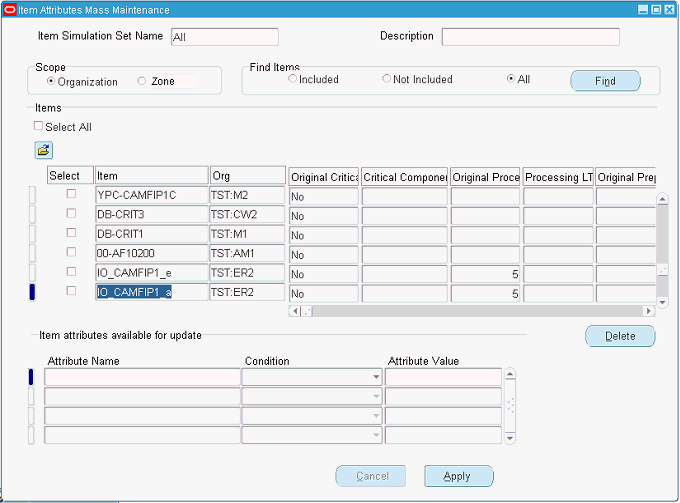
When you open the Item Attributes Mass Maintenance window from the Service Supply Chain Planner responsibility, you can either open an existing item simulation set or create a new item simulation set.
-
To access records for an existing item simulation set, in the header region, query the Item Simulation Set Name field, and then choose one of the existing item simulation sets.
The window is populated with information about the existing simulation set.
-
To create a new simulation set, in the header region, enter a unique name, and optionally a description, in the Item Simulation Set Name and Description fields.
-
To create a new simulation set, in the Scope region, you select either the Organization or the Zone radio button to define attributes at either the organization or zone level. All updateable attributes can be defined at the organization level. Only forecast attributes can be defined at the zone level. The only applicable item-zone attributes are the forecast rule for demand and supply, the sourcing rule related attributes, and the forecast accuracy metric and value.
-
In the Find Items region, click the Find button.
The Find Items window appears. You can create new find criteria, or use existing criteria to search for item and organization combinations. The find criteria includes the destination-only item attributes and the updated item attribute, which indicates whether any attribute has changed.
-
Define Find Items criteria to retrieve items for which you want to set Item Attributes values in this named Item Simulation Set. Click Find.
The Items region is populated with items that match the find items criteria.
-
In the Items region select a found item.
-
In the Item attributes available for update region, the Attribute Name column list of values shows item attributes that you can update by using mass maintenance functionality. See theUpdatable Attributes List. Select an updateable attribute from the LOV.
-
Select the Condition, and then specify the Attribute Value. The Condition operator works with the Attribute Value to modify the original value. For example, depending on the Condition operator, setting the Attribute Value to ‘10’ could overwrite the original attribute value with 10, increase the original value by 10, or decrease the original value by 10 percent. You select the Condition from the following list of values:
-
Set Value to
-
Increase by value
-
Increase by percentage
-
Decrease by value
-
Decrease by percentage
-
Set Original value
For more information about setting values for Item Attributes Available for Update, see:
-
You can delete all simulation sets except the seeded simulation set named Collected. In the Collected simulation set, you can delete only rows that you have created. Select the row, and then click the Delete button. This action deletes your updates, and reverts the Updated attribute value to No.
Folder Functionality
This form provides folder functionality for managing lists of returned records. The find criteria in the folder for mass maintenance includes all the updateable attributes using either the original or updated attribute values.
For example:
Planner equals User2 and Original Planner equals User1.
Updated Item AttributeItem Attribute
In the item simulation set, the field labeled Updated indicates whether updateable item attributes have changed. You can use this field as one of the criteria to find updated (or non-updated) item-organization combinations in the collected data.
Reverting to Original Values
For all the items that can be updated, the Original field retains the data for these attributes as originally collected. For example, the item attribute Critical Component has a related attribute called Original Critical Component that stores the collected data value. The original attribute always points to the latest collected data. The attribute itself, such as Critical Component, holds the updated values.
In the case of the seeded item simulation set named Collected, the original and the actual attributes are the same.
Reverting All Attribute Values
To change all of the attributes for an item-organization back to original values, that is, to restore the data as collected from the source for that item and organization combination, select the row for the item-organization. Then click Delete to delete the selected row from the simulation set.
Revert One Attribute Value
To change one or a subset of attributes for an item-organization back to their original values, select the rows for the item-organization combinations to be restored. In the Item attributes available for update region, select the row for the attribute that you want to change to the original value. In the Condition column, select the operator Set Original Value. This action replaces the updated attribute value from the simulation set data with the collected value. Planning uses the collected value.
Note: The Updated attribute reverts to No only after all the attribute updates are deleted for that item-organization combination.
Item Simulation Set Example
-
The user queries Item Attributes Mass Maintenance Simulation Set Name 1 to retrieve the following set of items, organizations, and attributes:
Original collected data Item Updated Org Repair Yield Forecast Set for Demand Aaa No M1 100% Single exponential Aaa No M2 90% Single exponential Aaa No M3 90% Single exponential -
The user makes the following changes to updatable item attributes, and saves the data.
Item: Aaa
Organization: M1
Row 1
Attribute Name: Repair Yield
Condition: Decrease value by percent
Attribute Value: 50
Row 2
Attribute Name: Forecast set for demand
Condition: Set value to
Attribute Value: Double exponential
----------
Item: Aaa
Organization: M3
Row 1
Attribute Name: Repair Yield
Condition: Set value to
Attribute Value: 50
-
All item and organization combinations that have changes are saved along with the corresponding changed attributes and attribute values. The user verifies the updated data by opening the Item Update window. The user also sees other item and organization combinations that were not changed.
Resulting data with updates overlying collected data Item Updated Org Repair Yield Forecast Set for Demand Aaa Yes M1 50% Double exponential Aaa No M2 90% Single exponential Aaa Yes M3 50% Single exponential -
In the source instance organization M2, the repair yield for item Aaa is changed to 80%. This data is collected.
-
A plan that is run using item simulation set 1 uses the following data.
Resulting data with new collection data and updates overlying collected data Item Updated Org Repair Yield Forecast Set for Demand Aaa Yes M1 50% Double exponential Aaa No M2 80% Single exponential Aaa Yes M3 50% Single exponential
Updateable Attributes List
The following table lists attributes that can be updated using Item Attributes Mass Maintenance window.
| Item Attribute | Edit in ODS | Validation |
|---|---|---|
| Critical Component | Yes | Yes or No |
| Preprocessing LT | Yes | Number |
| Processing LT | Yes | Number |
| Post processing. LT | Yes | Number |
| Fixed LT | Yes | Number |
| Variable LT | Yes | Number |
| Fixed Order Quantity | Yes | Number |
| Fixed Days Supply | Yes | Number |
| Shrinkage Rate | Yes | Number |
| Fixed Lot Multiple | Yes | Number |
| Minimum Order Quantity | Yes | Number |
| Maximum Order Quantity | Yes | Number |
| Carrying Cost | Yes | Number |
| Demand Time Fence Days | Yes | Number |
| Forecast Control | Yes | LOV: None, Consume, Consume and Derive |
| Planning Time Fence Days | Yes | Number |
| Standard Cost | Yes | Number |
| Net Selling Price | No | Number |
| PIP Flag | Yes | Yes or No |
| Selling Price | Yes | Number |
| Substitution Window | Yes | Number |
| Safety Stock Days | Yes | Number |
| Unit Weight | Yes | Number |
| Unit Volume | Yes | Number |
| Safety Stock Method | Yes | |
| Safety Stock Percent | Yes | Number |
| ABC Class | Yes | LOV from Valid collected ABC Classes |
| Planning Method | Yes | Not planned, MRP planned, MPS planned, MPP planned, MRP/MPP planned, MPS/MPP planned |
| DRP Planned | Yes | Yes or No |
| Max Inventory Days of Supply | Number | |
| Max Inventory Window | Yes | Number |
| Target Inventory Days of Supply | Yes | Number |
| Target Inventory Window | Yes | Number |
| Preposition Inventory | Yes | Yes or No |
| Repair LT | Yes | Number |
| Repair Yield | Yes | Number |
| Repair Program | Yes |
|
| Service Level | Yes | Number |
| Demand Fulfillment Lead Time | Yes | Number |
| Minimum Remaining Shelf Life (Days) | Yes | Number |
| Continuous Inter-Organization Transfers | Yes | |
| Convergent Supply Consumption | Yes | |
| Create Supply Flag | Yes | Yes or No |
| Divergent Supply Feed | Yes | |
| Exception Set | Yes | LOV |
| Inventory Use Up Date | Yes | |
| Make/Buy | Yes | LOV (Make/Buy) |
| Margin | Yes | |
| Weight UOM | Yes | LOV UOM |
| Volume UOM | Yes | LOV UOM |
| Rounding Control | Yes | Yes or No |
| ATP Flag | Yes | Yes or No |
| ATP Components Flag | Yes | Yes or No |
| Vendor Managed: Minimum Quantity | Yes | |
| Vendor Managed: Minimum Days of Supply | Yes | |
| Vendor Managed: Maximum Quantity | Yes | |
| Vendor Managed: Maximum Days of Supply | Yes | |
| Vendor Managed: Fixed Quantity | Yes | |
| Vendor Managed: Consigned | Yes | |
| Retirement Rate | Yes | |
| History Intermittency | Yes | Default: No |
Special Source Instance Attributes for Service Parts Planning
Item attributes in the source instance for use in Service Parts Planning include repair yield, repair lead time, repair program, and preposition inventory. These attributes are collected in planning and appear in the Item Attributes Mass Maintenance window. These attributes are available for query and updates as well.
Destination-Only Item Attributes
Service Parts Planning capability requires a set of attributes that are maintained only in the destination instance. Because logical organizations (technician organizations) can support many zones, you might want to forecast by zone. You set up forecast rules for the zones where usage data is collected. Destination-only item attributes include Forecast Rule for Demand and Forecast Rule for Returns. These attributes appear in the item query result and are available as part of the mass maintenance capability.
| Attribute | Description | Validation / LOV | Edit in ODS |
|---|---|---|---|
| Forecast Rule for Demand | This is the rule associated for forecasting demand for an item. | List of predefined forecast rules | Yes |
| Forecast Rule for Returns | This is the rule associated with forecasting the returns for an item. | List of predefined forecast rules | Yes |
| Life time buy date | The date for the lifetime buy | Date | Yes |
| End of life date | The date of the end of life for the spare part | Date > Life time buy date | Yes |
| Average demand beyond planning horizon | The average demand expected beyond planning horizon/period. | Number | Yes |
| Average returns beyond planning horizon | The average returns expected beyond planning horizon period. | Number | Yes |
| Return forecast time fence (Days) | The forecast time fence for return forecast | Number | Yes |
| Average Daily Demand | The average demand. | Number | Yes |
| Defective Item Cost | This reflects the cost of a defective part and will be used for cost based optimization plan and while computing Key Performance Indicators (KPI’s). | Number | Yes |
| Basis for average daily demand | The stream that is used to calculate the average daily demand. | Valid collected stream. | Yes |
| Standard Deviation for daily demand | The standard deviation for daily demand. | Number | Yes |
| Mean inter arrival | The mean inter-arrival time | Number | Yes |
| Standard deviation of inter-arrival | The standard deviation of inter-arrival times | Number | Yes |
| Inter-arrival distribution method | The inter arrival distribution method will be used by IO as defined by the user in calculating the safety stock. If the value of this attribute is Null and the forecast method for the item is Croston’s then inventory planning will assume this to be Poisson’s distribution. For all other forecast methods, inventory planning will assume this to be normal distribution. | Varchar | Yes |
| Forecasting process/ engine | In the destination, this attribute signifies that the particular item-organization data collected will be used for SPP or Demantra. This is a collected data only attribute that cannot be changed in a non empty collected simulation set and also sets one flag only for SPP versus Demantra. If the simulation set is Null and pointing to the collected data, then users can edit it in the window or mass update it using the filters and attributes. |
Varchar |
Criticality Matrix
Analyzing the cause, frequency, and effects of a spare part’s failure helps determine the importance of a given spare part to service operations. Service Parts Planning provides a framework of user-defined parameters that can be used to create flexible groups called criticality categories. These categories can be assigned to spare parts to create a criticality matrix.
The criticality matrix helps set up planning policies for the spare part items. These policies include planning method, frequency of planning, forecast methods and rules, and service levels. The criticality matrix helps determine service levels and demand fulfillment lead times (DFLT) that impact quantity and location of the spare parts inventory.
A criticality matrix can be broadly defined as a function of:
-
Item
-
Location
-
Standard Cost: The standard cost of the spare part
-
Margin: (selling price – standard cost)
-
Average daily demand
-
Lead time: Typically the lead time to procure the part, either repair or new buy
-
Reliability: Can be measured qualitatively or quantitatively, for example:
-
(qualitative) Reliability: high, medium, low
-
(quantitative) Failure frequency: mean time between failures (MTBF)
-
Repair frequency: mean time between repairs (MTBR)
-
Quantity of expected failures or repairs
-
Mean availability (or unavailability) over lifetime
-
Expected total uptime (or downtime) over lifetime
-
-
Failure impact: Measures the impact that failure of a spare part has on a product. Example values include:
-
Cosmetic
-
Impaired
-
Safety
-
Inoperable
-
-
Measure of deviation from forecast daily demand
-
Standard deviation
-
Coefficient of variation = Standard Deviation / Average Daily Demand
-
Mean absolute deviation (MAD)
-
Mean absolute percent error (MAPE)
-
The figure depicts a process flow for defining and using criticality:
-
Define the criticality category set and valid values for the category.
Note: No pre-seeded category set is named Criticality. You either define a new category set, or use an existing one as the category for defining criticality.
-
Specify the category set to be used for defining criticality in the profile option: MSC: Criticality Category Set.
-
Create criticality rules.
-
Assign criticality rules.
-
Manually, by using Item Attribute Mass Maintenance to manually assign a criticality rule to the criticality item attribute for selected items.
-
Automatically, by using the Criticality Matrix window to create and execute a query to assign the criticality rule to items that match the query.
-
Setting the MSC:Criticality Category Set Profile Option
Implementation of the Criticality Matrix uses Category Set functionality. No seeded category set is named Criticality. You either designate an existing category set for use in defining the criticality matrix, or create a new category set for this purpose. You designate which category set you will use for setting up the Criticality Matrix in the profile option MSC: Criticality Category Set.
If you have not designated a criticality category set, when you navigate to the Criticality Matrix window, this note appears.
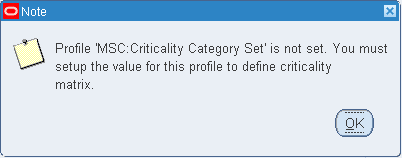
To set the profile
-
From the Service Supply Chain Planner responsibility, navigate to the Profile window.
Other > Profile
The Personal Profile Values window appears.
-
In the Profile Name column, inquire on Profile MSC:Criticality Category Set
-
Enter the name of the category set you want to designate for criticality functionality.
-
Click Save.
Criticality Rules
Within the criticality category set, you can create and save multiple criticality rule names. You do this on the Criticality Matrix window. For each criticality rule, you setup a sequence of criticality categories and query criteria corresponding to each category.
For example, the criticality category called Durable is set up with the following query:
-
Item Attribute: Standard Cost
-
Condition: At Least
-
Value: 500
And
-
Item Attribute: Reliability
-
Condition: Equals
-
Value: High
The criticality category called Disposable is set up with the following query:
-
Item Attribute: Selling Price
-
Condition: less than
-
Value: 50
Criticality Rule Assignment
There are two ways to assign Criticality Rules:
-
Manually
-
Automatically
Manual Assignment of Criticality Rule
Item-organization attribute mass maintenance has an attribute named Criticality. The validation for this field is a valid list of values from the category set pointed to by profile option MSC: Criticality Category Set.
While defining criticality, you can use the following updateable item-organization attributes filter criteria:
-
Cost (Standard cost)
-
Margin
-
Average daily demand
-
Lead times (various lead time types)
Attributes in the Item Attributes Mass Maintenance window that you may find useful when setting the criticality of a group of items include:
-
Reliability
-
Failure Impact
-
Standard Deviation
-
Coefficient of Variation = Standard Deviation / Average daily demand
Additionally, the Item Mass Maintenance window has user-defined attributes (User Attribute 1 through User Attribute 15) in the item-organization mass maintenance entity. You can specify any values, and then use these when setting criticality, or in general when performing item attribute mass maintenance. These attributes are also available as part of the Find criteria in the Item Attributes Mass Maintenance window.
| Attribute | Description | Validation LOV | Edit in ODS |
|---|---|---|---|
| Criticality | The definition of the severity of impact (or criticality) of a spare part on the install base end product. | Valid Categories in Criticality Category Set | Yes |
| Reliability | Reliability is an indication of the consistency of scores over time. | Varchar (None) | Yes |
| Failure Impact | The impact or effect of failure. | Varchar (None) | Yes |
| Standard deviation | The standard deviation is calculated by the concurrent program ‘Calculate average daily demand’. | Number | Yes |
| Coefficient of Variation (CV) | The coefficient of variation is calculated by the concurrent program ‘Calculate average daily demand’. | Number | Yes |
| User Attribute 1 through 15 | User defined attributes | None | Yes |
| Basis for average daily demand | The data stream that is used to calculate the average daily demand. | Valid collected stream. You cannot update the related attributes (Accuracy measure, Coefficient of Variation, and Average daily demand) until you specify the basis. | Yes |
Automated Assignment of Criticality Rule
You auto-assign criticality by executing query criteria that include attribute ranges for the dimensions of the criticality matrix, such as those listed previously (cost, reliability, failure impact, standard deviation, and so on), and any other item attributes that are part of the item simulation set. If needed, you can also employ User Attribute 1 through User Attribute 15.
Executing the query causes the criticality rule to be assigned to items matching the query criteria. When you execute the criticality criteria, the criticality category is assigned to the item and appears in the Item Attributes Mass Maintenance window as the Criticality attribute.
-
When the auto-assign process is re-run, manual updates are overwritten.
-
In case the auto-assign process has multiple rules or conditions that involve the same item, the process continues to override the previous category until all the queries are exhausted. The last updated category is retained as the Criticality category.
Differences Between Criticality Category and Item Categories
In Item Attributes Mass Maintenance, Category is not an updateable item attribute, whereas Criticality is an updateable attribute. Item categories do not change across item simulation sets, but the definition of Criticality can change.
Creating and Executing a Criticality Query
-
From the Service Supply Chain Planner responsibility, navigate to the Create Query window.
Setup > Manage Criticality matrix
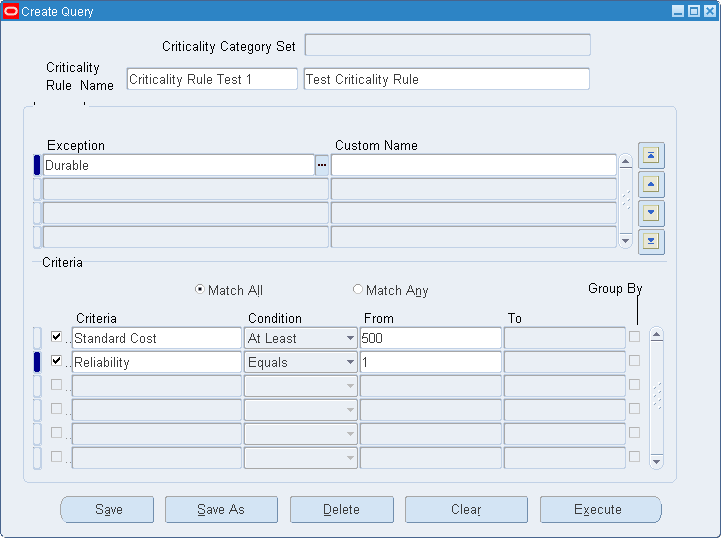
-
Specify the criticality rule name and description.
-
Criticality Assignment Set: This display only field shows the category set defined in the profile option MSC: Criticality Category Set.
-
Criticality Rule Name (and Description) – You can create and save different criticality rule names.
-
-
In the Criteria region, specify one or more criteria.
-
Criteria: The Criteria LOV includes all the attributes available in Item Attributes Mass Maintenance.
-
Condition: The Condition operator works with the From and To ranges. You select the Condition operator from the list of values.
-
From and To: Enter values for evaluating the criteria row.
-
-
To save the criticality rule without executing it, click Save.
-
To save the criticality rule against a different name, click Save As.
-
To erase the highlighted exception, click Delete.
-
To erase the selected criteria row, click Clear.
-
To auto-assign the criticality category to the items matching the query criteria, click Execute. You can view the output in the Item Attributes Mass Maintenance Criticality attribute.
